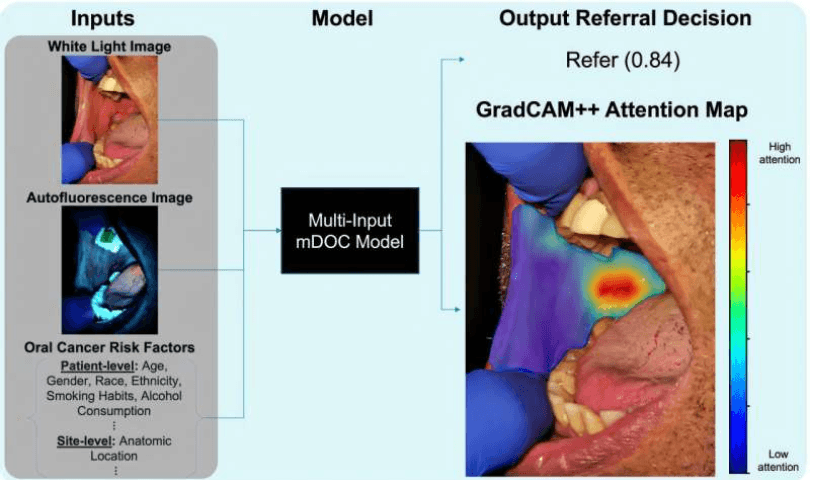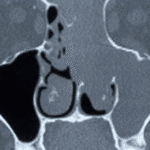Introduction
Oral cancer is one of the most preventable yet deadly diseases in India and worldwide. Despite the fact that the mouth is easily accessible for examination, many cases are still diagnosed too late for effective treatment. The issue often lies not in visibility but in recognition.
Dentists and hygienists are usually the first to notice abnormal lesions, but differentiating between harmless ulcers and early-stage cancers requires specialized expertise.
Now, thanks to AI-powered imaging, that gap could finally be bridged.
An innovation called mDOC (mobile Detection of Oral Cancer)—developed by researchers at Rice University — uses a smartphone-based imaging system to help dental professionals detect suspicious oral lesions early.
The Problem: Late Diagnosis in Oral Cancer
In India, oral cancer ranks among the top three types of cancer affecting both men and women, often linked to tobacco, betel nut, and alcohol use.
Despite routine dental visits, most cases are detected in advanced stages, when treatment options are limited and outcomes poor.
This is largely because:
- Early lesions look similar to benign ulcers or inflammation.
- Dentists in community setups often lack advanced diagnostic tools.
- Access to oncologists or oral pathologists is limited in smaller towns.
That’s where a mobile-based diagnostic device like mDOC can revolutionize early screening.
The Innovation: mDOC—A Smartphone-Based Detection Tool
The mDOC system combines white light imaging, autofluorescence, and machine learning algorithms to evaluate oral tissue health.
Here’s how it works:
- The dentist takes images of suspicious areas using a clip-on smartphone device.
- The device uses blue light to capture autofluorescence—where healthy tissue glows, but cancerous or precancerous tissue appears dark.
- The AI model then analyzes these images along with risk factors like smoking, age, and lesion site.
- Based on this analysis, the system recommends whether a specialist referral is needed.
This AI-assisted approach enhances accuracy, helping dentists make informed decisions and avoid unnecessary biopsies or referrals.
The Study: Testing the Power of Smart Detection
In the Biophotonics Discovery journal, mDOC was tested across 50 patients at two dental clinics in Houston, USA.
- Each patient had imaging done on up to five oral sites.
- Expert clinicians reviewed the images, and their decisions were used as the benchmark for training the algorithm.
- The model was refined using both new and existing data to simulate real-world, low-prevalence settings (where cancerous lesions are rare).
Results were promising:
- Sensitivity: 60% (correctly identified 60% of true cases)
- Specificity: 88% (accurately ruled out 88% of non-cancerous cases)
- The system outperformed human dental providers, who had 0% sensitivity, missing all cancerous cases in the study.
Although the model generated some false positives, these are preferable in preventive screening, as they ensure high vigilance and early intervention.
Why It Matters for Doctors and Dentists in India
For Indian doctors and dental professionals, this innovation could be game-changing.
India has one of the world’s highest oral cancer burdens, yet access to oncologists or advanced diagnostic centers is limited outside major cities.
With tools like mDOC, dentists and general practitioners could:
✅ Screen patients during routine check-ups using just a smartphone.
✅ Identify high-risk lesions early and refer appropriately.
✅ Reach rural and underserved populations with affordable, AI-assisted care.
✅ Integrate digital imaging into telemedicine workflows for expert consultations.
💡 At The Doctorpreneur Academy, we encourage doctors to explore such tech-driven screening models that make diagnostics accessible and affordable at the grassroots level.
The Doctorpreneur Perspective: Where AI Meets Compassionate Care
Digital tools like mDOC show the future of healthcare: personal, portable, and powered by AI.
For doctors in India, this innovation reinforces several key learnings:
- Technology can enhance, not replace, clinical judgment.
- AI-assisted screening can bridge the skill gap in early cancer detection.
- Collaboration between dentists, AI developers, and policymakers can make preventive oncology more effective.
- Integrating such tools in community health programs could drastically reduce cancer mortality rates.
Looking Ahead: Smarter, Faster, and More Inclusive Screening
The mDOC system takes just 3.5 minutes per patient, fitting seamlessly into daily dental workflows.
Future improvements aim to:
- Reduce false positives with better algorithms.
- Include more detailed patient histories for personalized analysis.
- Enable cloud-based data sharing for real-time specialist consultation.
Such innovations align perfectly with the Doctorpreneur vision—where doctors evolve into innovators, educators, and digital health leaders.
Conclusion
A smartphone catching oral cancer early might have sounded futuristic once; today, it’s becoming a reality.
The mDOC system is more than a gadget; it’s a glimpse into the next generation of preventive healthcare, where AI and accessibility unite to save lives.
💬 At The Doctorpreneur Academy, we believe the future doctor isn’t just a healer but a digital visionary—ready to bring such innovations from lab to life.
👉 To register for our next masterclass, please click here: https://linktr.ee/docpreneur




